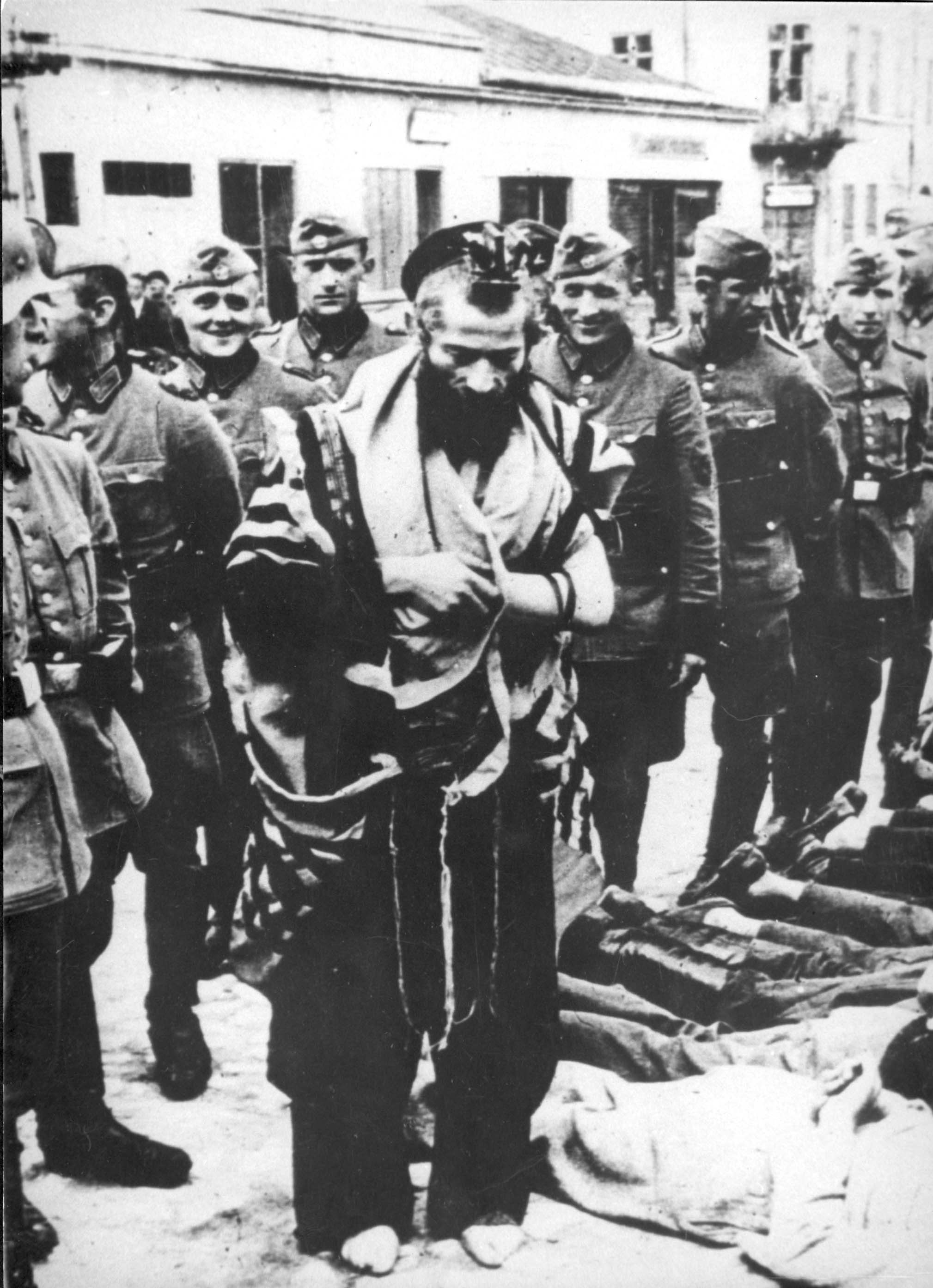One of the photograph collections from the Holocaust period that has aroused great curiosity is the series of pictures depicting German policemen and Jews in the Polish town of Olkusz. The best-known photograph in the series is also displayed in Yad Vashem's Holocaust History Museum, and shows German policemen forcing the local Rabbi to pray for their amusement. The photograph has been the subject of many explanations, most of which describe the Rabbi as standing next to the bodies of his congregants immediately after their murder by the Germans.
Yad Vashem Photo Archives 4613/903
In March 1940, approximately 3,000 Jews were living in Olkusz, including many refugees from other places. The town, named Ilkenau by the occupying German authorities, was annexed by the Reich as part of the Upper Silesia region. Although a ghetto was not established there, a Judenrat was appointed in the autumn of 1939. The Jews of Olkusz were subjected to various decrees from very early on in the occupation, but only two had been murdered1.
Accounts of the circumstances surrounding this photograph were found in two very different sources. The first is the Olkusz Yizkor book, which documents the fate of the community during the Holocaust period. In the book, the photograph forms part of the narrative of the events of that same day. The book describes how a German police unit arrived in Olkusz on 31 July 1940 and gathered all male residents over 14 years old, including all the Jewish men. in the main square. There the non-Jews and the Jews were forced to lie on the ground while the policemen and members of the SD “registered" them. During this process, the Germans maltreated and brutally beat the Jews. Two Poles and a Jew named Majer were killed during the operation.2
In order to further humiliate the Jews lying in the square, Rabbi Moshe Yitzhak Hagermann was made to don his Tallit (prayer shawl) and Tefillin (phylacteries), and to stand barefoot and pray next to some prostrate Jews. Hence the scene in the photograph. The Jews and the other men were permitted to return home that day, and the Germans left. Due to the beatings suffered by the Jews, the event was subsequently referred to as “Bloody Wednesday”3.
A similar story is documented in the second source: the investigation files against war criminals that were compiled in Germany in the ’50s and ’60s. A very similar version of the events is revealed in these files, which also add several details. According to the information in the files, the police activity on 31 July 1940 came in the wake of the killing of a German policeman, Ernest Kaddatz, by members of the Polish underground on 16 July 1940. All the town's men were concentrated in three places: next to Czarna Gora, next to the old Electric Company installations and in the market square. The photographs show the detainees in the market square and in one other place.
The men, including the Jews, were forced to lie face-down on the ground while the policemen and SD members “registered" them at a table set up there. Throughout the day, the German policemen kicked the men and beat them with their rifle butts. Tadeusz Lupa, a Polish electrician, could no longer bear the suffering, and tried to escape. The policemen shot and killed him. The Germans often justified executions by reporting them as ‘escape prevention’, and the reported circumstances of this murder are therefore suspect. This source also refers to the day as “Bloody Wednesday”4.
The photographs of the event were almost certainly taken by one of the policemen taking part in the operation. The series of photographs was copied over the years, and given such wide exposure that today, it is difficult to know which is a copy and which an original. It is common knowledge that German policemen in the East used to take pictures with their own cameras, and thus documented many of their anti-Jewish activities. In certain cases, there was even a “trading” of these photographs within the units5.
The Yad Vashem Archives holds at least one original photograph of the event. This private snapshot clearly depicts the unusual nature of the German police activity in Olkusz. During the operation, the Germans found time to pose together with the Jews for a humiliating joint photograph. The Jews of Olkusz were deported to Auschwitz in 1942, and most were murdered there 6. It is therefore safe to assume that the majority of the Jews in the photographs did not survive the Holocaust. Thanks to Yad Vashem’s Names Recovery Project, we know Rabbi Hagermann's fate: he was murdered in 1942, probably in Majdanek7.




- 1. Yad Vashem, Pinkas Hakehillot: Poland, Vol. VII, Jerusalem, Yad Vashem, 1999, p. 47 (Hebrew edition).
- 2. According to other sources, two Jews were shot and killed during the registration. Furthermore, it has been said that a number of the Polish intelligentsia were also murdered at the same time. See: ibid
- 3. Yashiv, Zvi (editor), The Olkusz Yizkor Book, Tel Aviv, Organization of Former Residents of Olkusz in Israel, 1972, pp125-132.
- 4. Dressen Willi, Ries Volker & Klee Ernst, Schone Zeiten, Frankfurt a/M, Fischer, 1988, pp15-17.
- 5. Goldhagen, Daniel Jonah, Hitler’s Willing Executioners: Ordinary Germans and the Final Solution, New York, Knopf, 1996.
- 6. Yad Vashem, Pinkas, p.48.
- 7. Yad Vashem, Hall of Names, 586427.
